 |
|||
|
Bright
high-altitude clouds imaged by Voyager 2.
|
|||
| THE ATMOSPHERE OF NEPTUNE | |||
| The Voyager encounter with Uranus was disappointing for those scientists interested in planetary atmospheres, for the atmosphere of Uranus is bland. The Voyager encounter with Neptune in 1986 made up for it, for Neptune's atmosphere appears to be far more dynamic, and to have more discernible features, than does Uranus'. | |||
| Atmospheric composition | |||
| Neptune's bright blue sphere gives the impression that the planet is covered by a global ocean. Responsible for Neptune's bright blue colour, however, is methane (CH4). Methane is better at absorbing red light, and blue light is reflected preferentially. Methane makes up just 2% of Neptune's atmosphere, the main constituents of which are hydrogen (H2) and helium (He). Hydrogen has an abundance of 80%, and helium 18%. The exact composition of the atmosphere is unknown - Voyager results give methane a figure of 3%, other methods give figures in the range of 1% to 10%. There are other trace gases to be found in the atmosphere, for example, water, carbon dioxide and ammonia. Nevertheless, Neptune is primarily a hydrogen planet. | |||
 Atmospheric composition. |
 Atmospheric composition. |
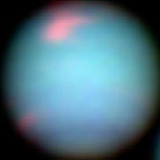 A Hubble Space Telescope near-infrared image reveals clouds (pink) of methane ice crystals. |
|
| Temperatures | |||
| A profile of Neptune's atmosphere shows how temperature varies with altitude. Where the pressure is equal to 0.1 atmospheres, the temperature is about 50 K (-223oC). This is the coldest part of the planet's atmosphere, well above the level of the main cloud layer. At 100 kilometres above and 100 kilometres below the 0.1 atmosphere level, the temperature has risen to 100 K (-173oC) . But with increasing depth the temperature rises steadily. Heat flowing from the interior is responsible for the slight differences in temperature between the poles and equator, and the mid latitudes. | |||
 Temperature profile through Neptune's + atmosphere. |
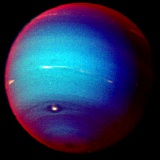 False colour imagery from Voyager 2 reveals a haze layer above Neptune's methane. |
||
| Spots and clouds | |||
| There appears to be far more activity within Neptune's atmosphere than Uranus'. There are a number of interesting features in Neptune's atmosphere. It has a Great Dark Spot (GDS), a large dark oval-shaped smear located in the southern hemisphere. Relative to the planet, the GDS is about the same size as the Great Red Spot is to Jupiter. The GDS is a storm system about the same size as the Earth. It is thought that the GDS is a plume of gas rising through the atmosphere, twisting as it does so. | |||
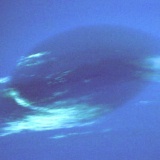 The Great Dark Spot. |
 The Great Dark Spot - a storm system the size of the Earth. |
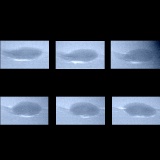 Voyager 2 observed changes in the Great Dark Spot. |
|
| There are other smaller spots visible on the surface of Neptune. South of the GDS is the Small Dark Spot (SDS). The SDS with its bright centre has a spooky eye-like appearance. | |||
 Neptune's Small Dark Spot. |
|||
| Recent Hubble Space Telescope images of Neptune show that its atmosphere has changed radically. The large dark spots have disappeared. The big question is will they return? They may have simply faded temporarily, just as Jupiter's Great Red Spot has done in the past. | |||
 Recent Hubble Space Telescope observations show the absence of the Great Dark Spot. |
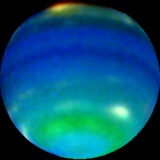 The Great Dark Spot has disappeared since the 1986 Voyager encounter, as shown in this Hubble Space Telescope view. |
||
| There are white wispy-looking high altitude clouds dispersed about the planet at roughly the same latitude. A large patch of these can be seen above the southern edge of the GDS and was nicknamed "Scooter" because it moves faster than the other white clouds, taking just under 17 hours to circle the planet. The white clouds are not confined to the latitude of the GDS, small patches are seen at other latitudes. | |||
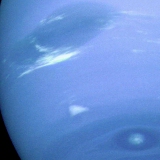 The positions of atmospheric features - Great Dark Spot (top), Scooter (middle), and Small Dark Spot (bottom). |
|||
| Neptune's clouds actually cast shadows onto the main cloud layer. It is the only one of the gas giants where this has been observed. The temperature of the high altitude clouds indicates that they are located between 50 and 100 kilometres above the blue "surface". | |||
 High altitude clouds casting shadows. |
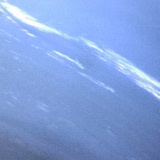 Bright clouds east of the Great Dark Spot show evidence of wave structure. |
||
| Additional cloud layers probably exist below the main deck where compounds may occur in different abundances. Their nature is of course highly speculative; some scientists have suggested that within the atmosphere at greater depths and under high pressure (100 atmospheres) there could be clouds of water ice. | |||
| Bands | |||
| Neptune has bands like those on Saturn and Jupiter, but they are fainter. The two darkest and most distinct bands encircle the planet at mid-latitudes in the southern and northern hemisphere at 55o. Moderately dark bands can also be seen at 25oN and 25oS. Like Jupiter's Southern Tropical Zone, which contains Jupiter's Great Red Spot, it is divided in two and has a northern and southern section. | |||
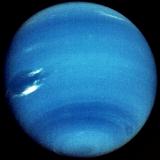 Dark bands encircle Neptune, as seen in this Voyager 2 image. |
 This enhanced Voyager 2 image shows the banded nature of Neptune's atmosphere. |
||
| Extreme speed | |||
| Timing the movement of Neptune's clouds has shown that it has some of the fastest winds in the Solar System. Logic suggests that Neptune ought to have slower winds because it is further from the Sun and there is less solar energy available to heat the atmosphere and generate currents. It turns out that the high winds are actually the result of Neptune's distance from the Sun. There is less heating from above to cause the turbulent flow which can slow winds down. | |||
| The winds instead are generated mainly by internal heating and flow in a laminar or sheet-like way around the planet. Heat flowing from the interior causes the mobile upper layers to circulate, creating winds which are helped around the planet by Neptune's rapid rotation. | |||
| The central (15oN to 15oS) latitudes have windspeeds in an easterly direction of more than 1260 kilometres per hour. At northern and southern latitudes of 70o winds in a westerly direction of more than 720 kilometres per hour have been recorded. This is far in excess of hurricane speeds on Earth. | |||
| The Voyager encounter with Neptune provided images that showed Neptunian atmospheric features in great detail for the first time. It would be a mistake to regard the images as showing Neptune "as it is". The dynamic atmosphere is constantly changing, and well-known features like the Great Dark Spot may no longer exist. Observations by the Hubble Space Telescope however, have revealed new features, for example, a new dark spot in Neptune's northern polar region. | |||
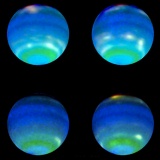 The constantly changing atmosphere of Neptune. |
 A new dark spot discovered by the Hubble Space Telescope. |
||
|
|
|||